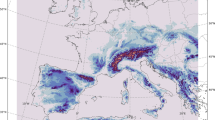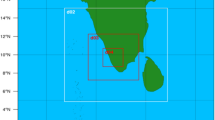Summary
The present study was for the purpose of determining the conditions necessary to the formation of radiation fog. The temperature and relative humidity of the lowest stratum of the troposphere were sounded with a tethered balloon and radiosonde during a number of nights when the conditions were considered favourable for the formation of radiation fog: clear weather with effective net radiation, light wind, and high relative humidity at ground level. Advection fog was also studied on some occasions for comparison. The measurements were carried out in Uppsala. Meteorological phenomena of possible importance to the study were recorded concurrently with the measurements. The weather was analyzed synoptically and aerologically also on each occasion.
The results of the investigation suggest that the conditions necessary to the formation of radiation fog are not only an effective net radiation, light wind, and high relative humidity at ground level, but also that the wind must be light and the relative humidity high at some distance above the ground. This permits the more or less marked surface inversion to leave ground level and to rise as a layer of rapid temperature transition. This is brought about by the radiation gradually emitting from the upper surface of the layer of mist or fog, formed in the lowest and chilled air strata, which are subsequently cooled from above until an unstable lapse rate develops. As a results, the layer of rapid temperature transition is maintained rather intact as it rises. If the radiation continues without obstruction and the wind is ligh aloft, this layer migrates upwards until it reaches a level at which the relative humidity is so low that the cooling necessary for condensation does not occur by radiation, limiting the extension of the underlying fog. If the relative humidity is high only in the undermost air strata, the surface inversion cannot leave ground level and no fog will be formed aloft. If the wind is strong aloft, the process is hindered by the increased turbulent exchange occurring between the high and low strata.
Zusammenfassung
Die vorliegende Untersuchung, die in Uppsala durchgeführt wurde, hat zum Zweck, die für die Bildung von Strahlungsnebel notwendigen Bedingungen festzulegen. Temperatur und relative Feuchtigkeit der untersten Troposphärenschicht wurden mit Fesselballon und Radiosonde während einer Anzahl Nächte ausgemessen, in denen die Bedingungen für die Bildung von Strahlungsnebel günstig erschienen, somit bei klarem Wetter mit effektiver Ausstrahlung, leichtem Wind und hoher relativer Feuchtigkeit am Boden. Zum Vergleich wurden auch einige Fälle von Mischungsnebel (Advektionsnebel) untersucht. Die Bestimmungen wurden in Uppsala durchgeführt. Gleichzeitig wurden auch weitere meteorologische Vorgänge, die für diese Untersuchung von Bedeutung sein konnten, aufgezeichnet. Zudem wurde das Wetter synoptisch und aerologisch bei jeder Gelegenheit un tersucht.
Die Ergebnisse dieser Untersuchung legen die Annahme nahe, daß die für die Bildung von Strahlungsnebel not wendigen Bedingungen nicht nur in effektiver Ausstrahlung, leichtem Wind und hoher relativer Feuchtigkeit am Boden bestehen, sondern daß auch in gewisser Entfernung über dem Boden der Wind schwach und die Feuchtigkeit hoch sein muß. Dadurch wird es der mehr oder weniger ausgesprochenen Bodeninversion ermöglicht, das Bodenniveau zu verlassen und als Schicht eines schnellen Temperaturüberganges in die Höhe zu steigen. Dies wird bewirkt durch die Ausstrahlung, die allmählich von der Oberseite der Nebelschicht ausgeht, welche sich in den untersten und ausgekühlten Luftschichten bildet, die sich nach und nach von oben her abkühlen, bis sich ein instabiler Temperaturgradient entwickelt. Infolgedessen wird die Schicht des schnellen Temperaturübergangs beim Emporsteigen nahezu unverändert aufrechterhalten. Falls die Ausstrahlung ungehindert andauert und der Wind auch in der Höhe schwach ist, wandert diese Schicht aufwärts, bis sie ein Niveau erreicht, wo die relative Feuchtigkeit so niedrig ist, daß die für Kondensation notwendige Abkühlung nicht mehr durch die Ausstrahlung hervorgerufen wird, wodurch die Ausdehnung des darunter liegenden Nebels begrenzt wird. Wenn dagegen die relative Feuchtigkeit nur in den alleruntersten Luftschichten hoch ist, kann die Bodeninversion die Höhe des Erdbodens nicht verlassen und es bildet sich haher in der Höhe kein Nebel. Falls in der Höhe starker Wind weht, wird der Prozeß der Nebeldung durch die verstärkten Austauschvorgänge zwischen den hohen und den niederen Schichten verhindert.
Résumé
Le but de la présente étude faite à Uppsala est de déterminer les conditions de formation du brouillard de rayonnement. On a mesuré à cet effet la température et l'humidité relative des couches basses de la troposphère à l'aide de ballons captifs et de radiosondes pendant un certain nombre de nuits apparement favorables à la formation de brouillard, done par temps clair, vent faible et forte humidité au sol. Quelques cas de brouillard d'advection ont été aussi retenus à titre de comparaison. En même temps on a relevé d'autres processus météorologiuqes pouvant être utiles; la situation météorologique fit l'objet d'une analyse synoptique et aérologique dans chaque cas.
Les résultats obtenus font penser que ce ne sont pas seulement le rayonnement, la faible agitation de l'air et la forte humidité relative au sol qui sont déterminants dans la formation du brouillard; le vent doit être faible et l'humidité élevée également à une certaine hauteur au-dessus du sol: c'est alors que l'inversion plus ou moins prononcée peut s'élever. Cela résulte du refroidissement par rayonnement de la surface du brouillard bas; la couche froide au sol augmente alors d'épaisseur jusqu'à ce qu'un gradient vertical instable apparaisse. La couche de décroissance rapide de température se maintient tout en gagnant vers le haut, et le processus ne s'arrête que lorsqu'un niveau à faible humidité est atteint; la couche de brouillard a alors acquis son épaisseur maximum. Si l'humidité relative n'est forte que dans les couches les plus basses, l'inversion ne peut par contre quitter le sol et il ne se forme pas de brouillard plus haut. S'il y a du vent fort a une certaine hauteur, le processus de formation du brouillard est rendu impossible par le brassage des couches basses et moyennes.
Similar content being viewed by others
References
Brunt, D.: Physical and Dynamical Meterrology. Cambridge 1934.
Fleagle, R. G., W. H. Parrot andM. L. Barad: Theory and Effects of Vertical Air Temperature Distribution in Turbid Air. J. Met.9, 53–60 (1952).
George, J. J.: Fog. Compendium of Meteorology, edited byT. Malone, pp. 1179–1189. Boston, 1951.
Gold, E.: Weather Forecasts. Quart. J. Roy. Met. Soc.73, 151–185 (1947).
Nurminen, A.: Some Aspects of Fog with Special Reference to South Finland. Ann. Acad. Sci. fenn. Helsinki, Ser. A, I. Matematica-Physica, No. 218 (1951).
Nyberg, A.: The Lag-Coefficient of Aerological Instruments and the Function of Hair Hygrometers at Low Temperatures. Medd. Met.-Hydr. Anst. Stockholm, serien uppsatser N:o 32 (1940).
Nyberg, A.: Om väderlekens inverkan p⇘ regulariteten av flygtrafiken. Medd. Met.-Hydr. Anst. Stockholm7, N:o 8 (1942).
Petterssen, S.: Weather Analysis and Forecasting. New York and London, 1940.
Petterssen, S.: Weather Analysis and Forecasting, second edition, Vol. II. New York, Toronto and London, 1956.
Robinson, E., andG. B. Bell Jr.: Low-Level Temperature Structure under Alaskan Ice Fog Conditions. Bull. Amer. Met. Soc.37, 506–513 (1956).
Spinnangr, G.: On Fog over Snow-Covered Ground in Finnmarksvidda. Met. Ann. Oslo3, No. 1, 1948.
Taylor, G. I.: The Formation of Fog and Mist. Quart. J. Roy. Met. Soc.43, 241–268 (1917).
Author information
Authors and Affiliations
Additional information
Dedicated to Dr.Anders K. Ångström on the occasion of his 70th birthday.
With 12 Figures
Rights and permissions
About this article
Cite this article
Morales, C. Synoptic and mesoaerological study of radiation fog. Arch. Met. Geoph. Biokl. A. 10, 387–409 (1958). https://doi.org/10.1007/BF02247153
Published:
Issue Date:
DOI: https://doi.org/10.1007/BF02247153




